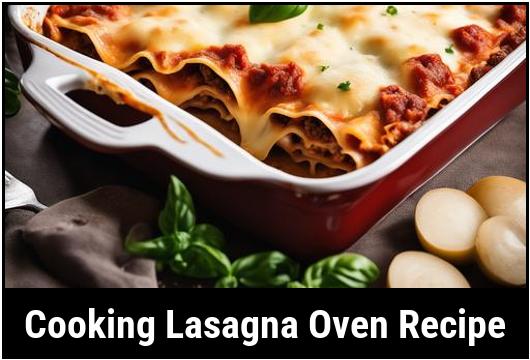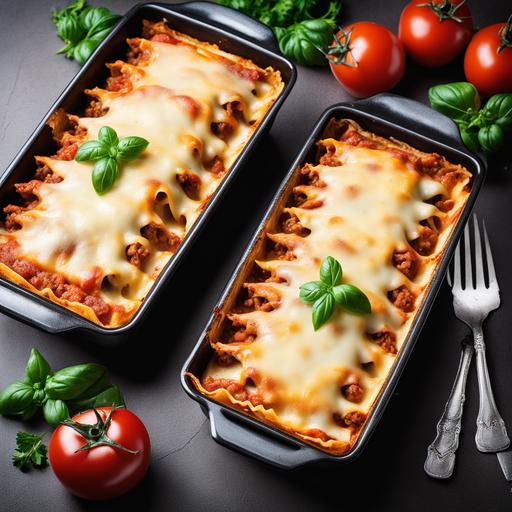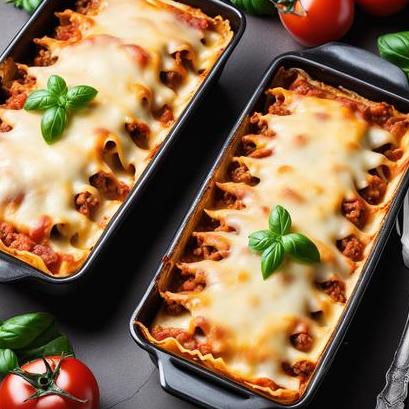
Cooking Lasagna Oven Recipe: A Masterclass In Flavor And Satisfaction
Lasagna is an Italian classic that never fails to impress. Its layers of rich, cheesy goodness, combined with savory sauces and tender pasta, tantalize our taste buds and bring joy to our hearts. While preparing this delectable dish may seem daunting at first, fear not! In this comprehensive guide, we will delve into every aspect of cooking lasagna in the oven. From understanding the food science behind it to mastering culinary techniques, we will share tips, variations, and key insights to ensure your lasagna turns out absolutely divine.
Understanding Food Science: The Art of Layering Flavors
Cooking is an art, and lasagna is all about harmonizing flavors and textures. To truly appreciate the intricacies of lasagna, let’s explore the food science behind it.
-
Pasta Selection: Choosing the right pasta is crucial. Traditional lasagna noodles are wide and flat, allowing sufficient surface area to hold the sauces and fillings. Opt for either oven-ready lasagna noodles, which eliminate the need for boiling, or precook regular noodles until they are al dente.
-
Cheese Selection: Cheeses play a vital role in lasagna, adding creaminess and depth of flavor. The classic combination of mozzarella, Parmesan, and ricotta creates a perfect balance. Mozzarella’s meltability, Parmesan’s nuttiness, and ricotta’s velvety texture complement each other beautifully.
-
Meat and Vegetable Preparation: Preparing the meat and vegetables require precision to achieve optimal taste. When selecting ground meats like beef or sausage, opt for lean cuts to prevent excessive grease. Saute the vegetables, such as onions, garlic, and bell peppers, to release their natural flavors and aromas.
-
Sauces and Seasonings: A great lasagna relies heavily on its sauces and seasonings. The marinara or meat sauce acts as a binding agent between the layers. Experiment by adding herbs like basil, oregano, or thyme to impart delightful aromatics.
Culinary Details: Nailing the Techniques
While assembling the lasagna may seem straightforward, attention to detail ensures a flawless outcome. Paying homage to the culinary techniques involved will elevate your lasagna to new heights.
Layering Like a Pro
-
Sauce Foundation: Begin by spreading a thin layer of sauce at the bottom of the baking dish. This prevents the noodles from sticking and adds moisture to the final dish.
-
Noodle Placement: Arrange the first layer of noodles over the sauce. Slightly overlap the noodles to create a sturdy foundation. If using oven-ready noodles, ensure they are covered in sauce to allow for proper hydration during cooking.
-
Ricotta and Cheese: Spoon dollops of ricotta on top of the noodles and gently spread it using the back of a spoon. Sprinkle a generous amount of shredded mozzarella and grated Parmesan to impart that cheesy allure.
-
Meaty or Vegetarian Filling: Add a layer of your chosen filling, whether it’s cooked ground meat or sauteed vegetables. Ensure even distribution for consistent flavors in each bite.
-
Repeat, Rejoice: Repeat the process, layering sauce, noodles, ricotta, cheese, and filling until the baking dish is nearly full. Finish with a final layer of noodles, sauce, and an indulgent amount of cheese for that irresistible golden crust.
The Baking Magic
-
Covering with Foil: Tent aluminum foil over the lasagna to trap moisture and prevent excessive browning during the initial baking phase. This ensures evenly cooked noodles without any dry edges.
-
Perfect Timing: Bake the lasagna in a preheated oven at 375°F (190°C) for approximately 45 minutes. This allows the flavors to meld while the noodles cook to perfection.
-
Uncovering and Browning: Remove the foil and increase the oven temperature to 425°F (220°C) for the final 15 minutes. This step imparts a beautiful golden-brown crust, adding an enticing crunch to your lasagna.
Top Tips for a Spectacular Lasagna

Enhance your lasagna game with these invaluable tips and tricks:
-
Well-Seasoned Sauce: Ensure your sauce is seasoned to perfection, as it permeates every layer of the lasagna. Balance acidity, sweetness, and saltiness by tasting and adjusting accordingly.
-
Rest Before Serving: Allow the lasagna to rest for at least 15 minutes after removing from the oven. This allows the layers to set and facilitates easy slicing, preventing your lasagna from turning into a delicious but messy heap.
-
Make-Ahead Convenience: Lasagna is a fantastic make-ahead dish. Prepare it a day in advance, refrigerate, and bake it when needed. This not only saves time but also allows the flavors to meld for a more robust taste.
-
Freezing for Future Delights: Cut the lasagna into individual portions, wrap them tightly in foil, and freeze for later use. These delightful parcels of flavor will save the day during busy weeks or unexpected guests.
Variations to Ignite Your Creativity

Lasagna is wonderfully versatile, accommodating a myriad of delicious variations. Here are a few inspirations to get your culinary creativity flowing:
-
Vegetarian Delight: Replace the meat with layers of grilled vegetables such as zucchini, eggplant, and bell peppers. Experiment with adding a smear of sun-dried tomato pesto between the layers for an extra burst of flavor.
-
Seafood Sensation: Delight your taste buds with a seafood-inspired lasagna. Combine sauteed shrimp, scallops, and chunks of white fish with a creamy garlic and white wine sauce. Sprinkle with fresh herbs like dill or parsley for a delightful oceanic twist.
-
Spinach and Artichoke Surprise: Layer cooked spinach, creamy artichoke hearts, and a luscious white sauce spiked with garlic and nutmeg. This vegetarian twist will captivate even the most devout meat lovers.
Checking for Doneness: The Ultimate Taste Test

Determining the perfect moment to take your lasagna out of the oven involves employing your senses. Here’s how to carry out the ultimate taste test:
-
Probe and Observe: Insert a toothpick or fork into the lasagna’s center, ensuring it goes through all the layers. Withdraw it and observe. If the toothpick comes out with minimal resistance and no uncooked noodle bits, your lasagna is ready.
-
Visual Cue: The lasagna’s top should be a beautiful golden hue, indicating a well-baked, crispy layer of cheesy goodness. Avoid overcooking, which may result in burnt corners or dehydrated noodles.
The Perfect Lasagna Oven Recipe

After exploring every facet of cooking lasagna, here’s a delicious and foolproof recipe to create a masterpiece of your own:
Ingredients:
-
1 pound (450g) lean ground beef
-
1 onion, finely diced
-
3 garlic cloves, minced
-
1 red bell pepper, diced
-
2 cups marinara sauce
-
9 oven-ready lasagna noodles
-
2 cups ricotta cheese
-
2 cups shredded mozzarella cheese
-
1 cup grated Parmesan cheese
-
1 teaspoon dried oregano
-
1 teaspoon dried basil
-
Salt and pepper to taste
-
Fresh basil or parsley for garnish (optional)
Instructions:
-
Preheat the oven to 375°F (190°C) and lightly grease a 9×13-inch baking dish.
-
In a large pan, cook the ground beef over medium heat until browned. Add the diced onions, minced garlic, and diced bell pepper. Saute until the vegetables are tender.
-
Stir in the marinara sauce, dried oregano, dried basil, salt, and pepper. Simmer the mixture for 10 minutes to allow the flavors to meld.
-
Spread a thin layer of the sauce at the bottom of the prepared baking dish.
-
Arrange 3 lasagna noodles over the sauce, ensuring they slightly overlap. Spread 1/3 of the ricotta cheese on top. Sprinkle 1/3 of the mozzarella and Parmesan cheese.
-
Spoon 1/3 of the meat sauce over the cheese layer. Repeat the layering process with the remaining ingredients, ending with a layer of noodles, sauce, mozzarella, and Parmesan cheese.
-
Tent aluminum foil over the lasagna and bake for 45 minutes.
-
Remove the foil, increase the oven temperature to 425°F (220°C), and bake for an additional 15 minutes for a golden-brown crust.
-
Let the lasagna rest for 15 minutes before serving. Garnish with fresh basil or parsley if desired.
Overcooking and Undercooking: Potential Pitfalls
While every effort has been made to guide you towards a perfectly cooked lasagna, sometimes mishaps occur. Understanding the signs of overcooking and undercooking will help troubleshoot these potential pitfalls.
-
Overcooking: If the lasagna’s edges appear excessively browned or burnt, it may indicate overcooking. Additionally, the noodles may become too soft and lose their structure, resulting in a mushy texture.
-
Undercooking: Undercooking surfaces when the noodles remain crunchy or slightly undercooked. If the toothpick test suggests resistance or visible uncooked noodle bits, your lasagna needs a bit more time in the oven.
Cleaning Up: Hassle-Free Maintenance
Lasagna may be a labor of love, but cleaning up doesn’t have to be a daunting task. Follow these easy steps for a hassle-free cleaning experience:
-
Prevention is Key: Prior to baking, ensure your baking dish is generously greased or lined with parchment paper. This prevents the lasagna from sticking to the dish, making it easier to clean afterward.
-
Soak and Scrub: Fill the dish with warm, soapy water immediately after removing the lasagna. Allow it to soak for approximately 30 minutes. Gently scrub the dish using a sponge or non-abrasive brush to remove any residue.
-
Utilize Baking Soda: Stubborn stains or baked-on cheese can be treated by sprinkling baking soda on the affected areas. Add a few drops of water to create a paste and let it sit for an additional 15 minutes before scrubbing.
With these cleaning methods, your baking dish will be pristine, ready for your next culinary endeavor.
Conclusion
Congratulations! You have now embarked on a culinary journey that demystifies the art of cooking lasagna in the oven. Armed with knowledge of food science, culinary techniques, tips, and variations, your lasagna endeavors are destined for success. Be creative, experiment with flavors, and most importantly, savor the joy of sharing this timeless dish with loved ones. Remember, cooking lasagna isn’t just about nourishing the body but also nurturing the soul.
FAQS On Cooking Lasagna Oven Recipe
What Ingredients Are Needed For Cooking Lasagna In The Oven Recipe?
The ingredients for lasagna in the oven recipe include lasagna noodles, ricotta cheese, mozzarella cheese, Parmesan cheese, ground beef, tomato sauce, onion, garlic, salt, pepper, and olive oil.
What Steps Do I Need To Follow To Cook A Delicious Lasagna In The Oven?
Cook the noodles, brown the beef, prepare the sauce, mix the ricotta cheese, layer the ingredients, and bake in the oven for 45 minutes.
Can I Prepare Lasagna In Advance And Refrigerate It Before Baking It In The Oven?
Yes, you can prepare lasagna in advance and refrigerate it before baking in the oven. Just cover it tightly with plastic wrap and aluminum foil to prevent it from drying out.
Do I Need To Cover The Lasagna With Aluminum Foil While Baking In The Oven?
Yes, it is recommended to cover lasagna with aluminum foil for the first 30 minutes of baking to allow it to cook evenly. Remove the foil for the last 15 minutes to get a crispy top layer.
What Temperature Should I Bake Lasagna In The Oven And For How Long?
Lasagna should be baked at 375-400°F for 45-50 minutes, or until it is hot and bubbling. Make sure that the internal temperature is at least 160°F before serving.



